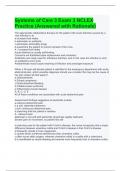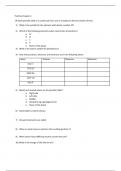Systems of Care 3 Exam 3 NCLEX Practice (Answered with Rationale)
The appropriate collaborative therapy for the patient with acute diarrhea caused by a viral infection is to
a.increase fluid intake.
b.administer an antibiotic.
c.administer antimotility drugs.
d.quarantine the patient to prevent spread of the virus.
A - Increase fluid intake
Acute diarrhea is usually self-limiting
Concerns are fluid/electrolyte replacement and resolution
Antibiotics are rarely used for infectious diarrhea, and in this case the infection is viral so antibiotics won't work
Antidiarrheals would cause retaining of infection and prolonged exposure
When a 35-year-old female patient is admitted to the emergency department with acute abdominal pain, which possible diagnosis should you consider that may be the cause of
her pain (select all that apply)?
a.Gastroenteritis
b.Ectopic pregnancy
c.Gastrointestinal bleeding
d.Irritable bowel syndrome
e.Inflammatory bowel disease
A, B, C, D, E
All of these conditions are associated with acute abdominal pain
Assessment findings suggestive of peritonitis include
a.rebound abdominal pain.
b.a soft, distended abdomen.
c.dull, continuous abdominal pain.
d.observing that the patient is restless.
A - rebound pain
Abdomen is not soft with peritonitis (board-like rigidity hallmark)
Severe pain w/ movement, so patient lies still
In planning care for the patient with Crohn's disease, the nurse recognizes that a major difference between ulcerative colitis and Crohn's disease is that Crohn's disease
a.frequently results in toxic megacolon.
b.causes fewer nutritional deficiencies than ulcerative colitis.
c.often recurs after surgery, whereas ulcerative colitis is curable with a colectomy.
d.is manifested by rectal bleeding and anemia more frequently than is ulcerative colitis. C - Crohn's disease often recurs after surgery, whereas UC is curable w/ colectomy
UC only affects rectum and colon, can cause bleeding, but no nutrient malabsorption (doesn't affect SI/LI)
Crohn's disease involves ileum, where bile salts and vitamins are absorbed.
The nurse performs a detailed assessment of the abdomen of a patient with a possible bowel obstruction, knowing that manifestations of an obstruction in the large intestine are (select all that apply)
a.persistent abdominal pain.
b.marked abdominal distention.
c.diarrhea that is loose or liquid.
d.colicky, severe, intermittent pain.
e.profuse vomiting that relieves abdominal pain.
A, B
Persistent abdominal pain and marked distention
With lower intestinal obstruction, onset is gradual, vomiting is rare and absolute constipation occurs, no diarrhea
A patient with stage I colorectal cancer is scheduled for surgery. Patient teaching for this patient would include an explanation that
a.chemotherapy will begin after the patient recovers from the surgery.
b.both chemotherapy and radiation can be used as palliative treatments.
c.follow-up colonoscopies will be needed to ensure that the cancer does not recur.
d.a wound, ostomy, and continence nurse will visit the patient to identify an abdominal site for the ostomy.
C - follow-up colonoscopies will be needed to ensure that cancer does not recur
Stage 1 colorectal cancer is treated surgically, no ostomy, no chemotherapy
Colorectal cancer can recur
The nurse explains to the patient undergoing ostomy surgery that the procedure that maintains the most normal functioning of the bowel is
a.a sigmoid colostomy.
b.a transverse colostomy.
c.a descending colostomy.
d.an ascending colostomy.
A - sigmoid colostomy
The more distal the ostomy, the more the intestinal function is normalized - contents expelled resemble feces
Some patients can regulate sigmoid colostomy, so collection bag is not needed
In contrast to diverticulitis, the patient with diverticulosis
a.has rectal bleeding.
b.often has no symptoms.
c.has localized cramping pain.
d.frequently develops peritonitis. B - often has no symptoms
Diverticulitis is inflammation, can lead to obstruction or perforation
Diverticulosis is presence of outpouchings, w/o inflammation
A nursing intervention that is most appropriate to decrease postoperative edema and pain after an inguinal herniorrhaphy is
a.applying a truss to the hernia site.
b.allowing the patient to stand to void.
c.supporting the incision during coughing.
d.applying a scrotal support with ice bag.
D - applying a scrotal support with ice bag
Scrotal edema is a painful complication of inguinal hernia repair
Scrotal support w/ ice can relieve pain and edema
The nurse determines that the goals of dietary teaching have been met when the patient
with celiac disease selects from the menu
a.scrambled eggs and sausage.
b.buckwheat pancakes with syrup.
c.oatmeal, skim milk, and orange juice.
d.yogurt, strawberries, and rye toast with butter.
A - scrambled eggs and sausage
Celiac disease is treated by avoiding gluten
Wheat, barley, oars, and rye should be avoided
Oats do not contain gluten, but are often contaminated during processing/milling
Gluten is also found in many medications, food additive, preservatives, and stabilizers
What should a patient be taught after a hemorrhoidectomy?
a.Take mineral oil before bedtime.
b.Eat a low-fiber diet to rest the colon.
c.Administer oil-retention enema to empty the colon.
d.Use prescribed pain medication before a bowel movement.
D - use prescribed pain medication before bowel movements
Reduces discomfort
Avoid straining - high-fiber diet is recommended, stool softeners
If no BM for several days, use oil-retention enema
The nurse is admitting a 68-year-old man with severe dehydration and frequent watery diarrhea. He just completed a 10-day outpatient course of antibiotic therapy for bacterial
pneumonia. It is most important for the nurse to take which action?
a.Wear a mask to prevent transmission of infection.
b.Wipe equipment with ammonia-based disinfectant.
c.Instruct visitors to use the alcohol-based hand sanitizer.
d.Don gloves and gown before entering the patient's room.
D - Don gloves and gown before entering the patient's room
C diff is an antibiotic-associated diarrhea transmitted by contact, and the spores are extremely difficult to kill. Patients should be placed in a private room and gloves and gowns should be worn. Alcohol-based hand cleaners and ammonia-based disinfectants are ineffective. Equipment cannot be shared with other patients, and a disposable stethoscope and individual patient thermometer are kept in the room. Objects should be
disinfected with a 10% solution of household bleach.
After an abdominal hysterectomy, a 45-year-old woman complains of severe gas pains. Her abdomen is distended. It is most appropriate for the nurse to administer which prescribed medication?
a.Morphine sulfate
b.Ondansetron (Zofran)
c.Acetaminophen (Tylenol)
d.Metoclopramide (Reglan)
D - Metoclopramide (Reglan)
Swallowed air and reduced peristalsis after surgery can result in abdominal distention and gas pains. Early ambulation helps restore peristalsis and eliminate flatus and gas pain. Medications used to reduce gas pain include metoclopramide (Reglan) or alvimopan (Entereg) to stimulate peristalsis.
A 20-year-old man is admitted to the emergency department after a motor vehicle crash
with suspected abdominal trauma. What assessment finding by the nurse is of highest priority?
a.Nausea and vomiting
b.Hyperactive bowel sounds
c.Firmly distended abdomen
d.Abrasions on all extremities
C - Firmly distended abdomen
Clinical manifestations of abdominal trauma are guarding and splinting of the abdominal
wall; a hard, distended abdomen (intraabdominal bleeding); decreased bowel sounds; contusions over the abdomen; abdominal pain; pain over the scapula; hematemesis or hematuria; and signs of hypovolemic shock.
The nurse identifies that which patient is at highest risk for developing colon cancer?
a.A 28-year-old male who has a body mass index of 27 kg/m2
b.A 32-year-old female with a 12-year history of ulcerative colitis
c.A 52-year-old male who has followed a vegetarian diet for 24 years
d.A 58-year-old female taking prescribed estrogen replacement therapy
B - A 32-year-old female with a 12 year history of ulcerative colitis
Risk includes history of inflammatory bowel disease (especially UC >10 years); obesity (BMI ≥ 30); family or personal history of colorectal cancer, adenomatous polyposis, hereditary nonpolyposis colorectal cancer syndrome; red meat; cigarette use; and alcohol.
A 58-year-old woman is being discharged home today after ostomy surgery for colon cancer. The nurse should assign the patient to which staff member?
a.A nursing assistant on the unit who also has hospice experience
b.A licensed practical nurse who has worked on the unit for 10 years





